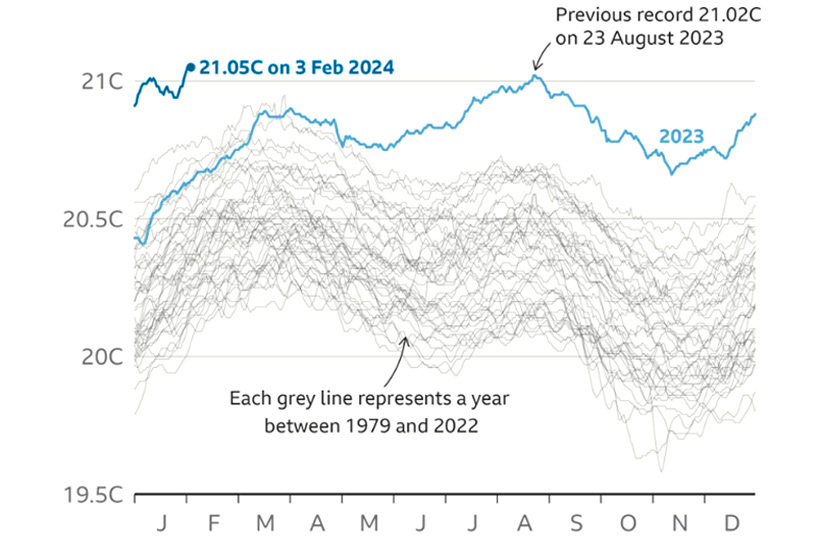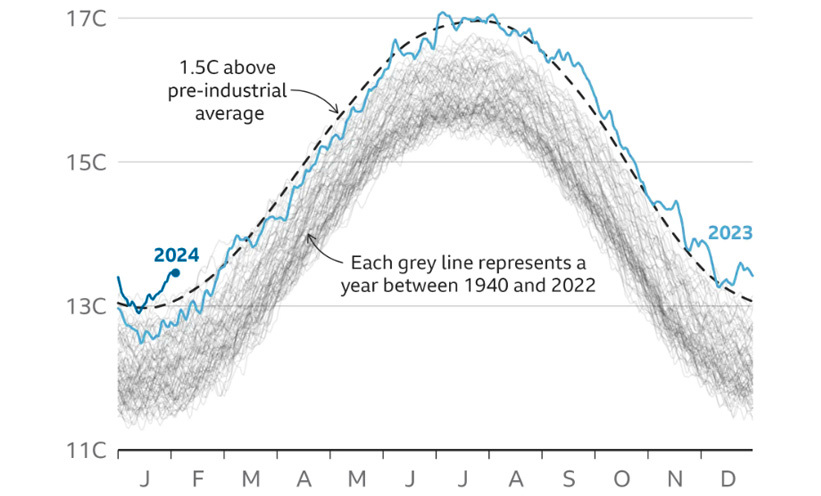The global average temperature has breached the 1.5°C benchmark for 12 consecutive months, with January 2024 being the hottest January since records began. Scientists are sounding the alarm stating that, while the global average for the last 12 months does not imply a failure to meet the Paris Agreement, the window to take immediate actions is shrinking.
According to the EU’s Copernicus Climate Change Service (C3S), the global average temperature in January 2024 was 13.14°C which is 0.70°C higher than the 1850-1900 pre-industrial average and 0.12°C above the previous warmest January in 2020.
“The month was 1.66°C warmer than an estimate of the January average for 1850-1900, the designated pre-industrial reference period,” the report noted.
Furthermore, the global mean temperature for the last 12 months was the highest since records began in 1940, exceeding the 1991-2020 average by 0.64°C and the pre-industrial average by 1.52°C.
Fig.1. Average global air temperature compared with pre-industrial levels, running average of 365 days
Source: BBC
The increase in air temperature varied across regions. In Europe’s northern countries, the average temperature was much below the 1991-2020 average whereas, in the south of the continent, the average was significantly above this. The average air temperatures in the Middle East, north-western Africa, eastern Canada, and central Asia were significantly above the average whereas in other places, such as most of eastern Siberia, the central USA, and western Canada, the average temperature was below the previous 1991-2020 averages.
Another sign of widespread global warming is the increase in sea surface temperatures with C3S reporting that the global sea surface recorded its highest temperature in January 2024. According to the agency, last month the average global sea surface temperature over the global extrapolar ocean (60 degrees south to 60 degrees north) reached a record high of 20.97°C which is 0.26°C warmer than the previous warmest January in 2016, and just 0.01°C above the highest record in August 2023.
Fig.2. Daily average sea surface temperature between 60° North and 60° South, 1979 – 2024

Source: BBC
This increase is seen as a consequence of the general global warming trend as, since the late 1970s, the global temperature has risen on average by 0.2°C per decade. However, El Niño, a natural climate-warming phenomenon, has also played a significant role in this alarming temperature rise. The global average temperature started to exceed the 1.5°C mark in the second half of 2023 when El Niño began, and this trend continued into 2024.
Fig.3. Daily global average air temperature, 1940 – 2024

Source: BBC
The C3S findings may point to the failure of the 2015 Paris Agreement whose goal was to limit the temperature rise to 1.5C, a benchmark seen as crucial to avoid disastrous natural hazards. However, Francesca Guglielmo, a senior scientist from C3S, cautiously noted that the record-breaking temperatures do not mean that humanity has already failed, and the Paris Agreement is not achievable.
“Having reached this level for such a sustained period… may imply that the time between now and when the Paris Agreement limit is breached is shrinking,” she specified.
“Rapid reductions in greenhouse gas emissions are the only way to stop global temperatures increasing” C3S deputy director Samantha Burgess said.

